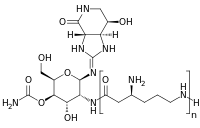Nourseothricin
Nourseothricin (NTC) is a member of the streptothricin-class of aminoglycoside antibiotics produced by Streptomyces species. Chemically, NTC is a mixture of the related compounds streptothricin C, D, E, and F.[1] NTC inhibits protein synthesis by inducing miscoding. It is used as a selection marker for a wide range of organisms including bacteria, yeast, filamentous fungi, and plant cells. It is not known to have adverse side-effects on positively selected cells, a property cardinal to a selection drug.[2]
 n=1-4 | |
| Names | |
|---|---|
| IUPAC name
[(2R,3S,4R,5R,6R)-6-[[(3aS,7R,7aS)-7-hydroxy-4-oxo-1,3a,5,6,7,7a-hexahydroimidazo[4,5-c]pyridin-2-yl]amino]-5-[[(3S)-3,6-diaminohexanoyl]amino]-4-hydroxy-2-(hydroxymethyl)oxan-3-yl] carbamate | |
| Identifiers | |
| |
3D model (JSmol) |
|
| ChEMBL | |
PubChem CID |
|
| |
| |
| Properties | |
| C19H34N8O8 | |
| Molar mass | 502.529 g·mol−1 |
| ~ 1 g/L | |
Except where otherwise noted, data are given for materials in their standard state (at 25 °C [77 °F], 100 kPa). | |
| Infobox references | |
NTC can be inactivated by nourseothricin N-acetyl transferase (NAT) from Streptomyces noursei, an enzyme that acetylates the beta-amino group of the beta-lysine residue of NTC.[3] NAT can thus act as an antibiotic resistance gene.
Properties
NTC is highly soluble in water (~ 1 g/mL) and stable in solution for 2 years at 4 °C.[4]
References
- Nourseothricin
- Kochupurakkal BS, Iglehart JD (2013). "Nourseothricin N-acetyl transferase: a positive selection marker for mammalian cells". PLoS ONE. 8 (7): e68509. doi:10.1371/journal.pone.0068509. PMC 3701686. PMID 23861913.
- Krügel H, Fiedler G, Smith C, Baumberg S (1993). "Sequence and transcriptional analysis of the nourseothricin acetyltransferase-encoding gene nat1 from Streptomyces noursei". Gene. 127 (1): 127–31. doi:10.1016/0378-1119(93)90627-f. PMID 8486278.
- NTC properties, Jena Bioscience